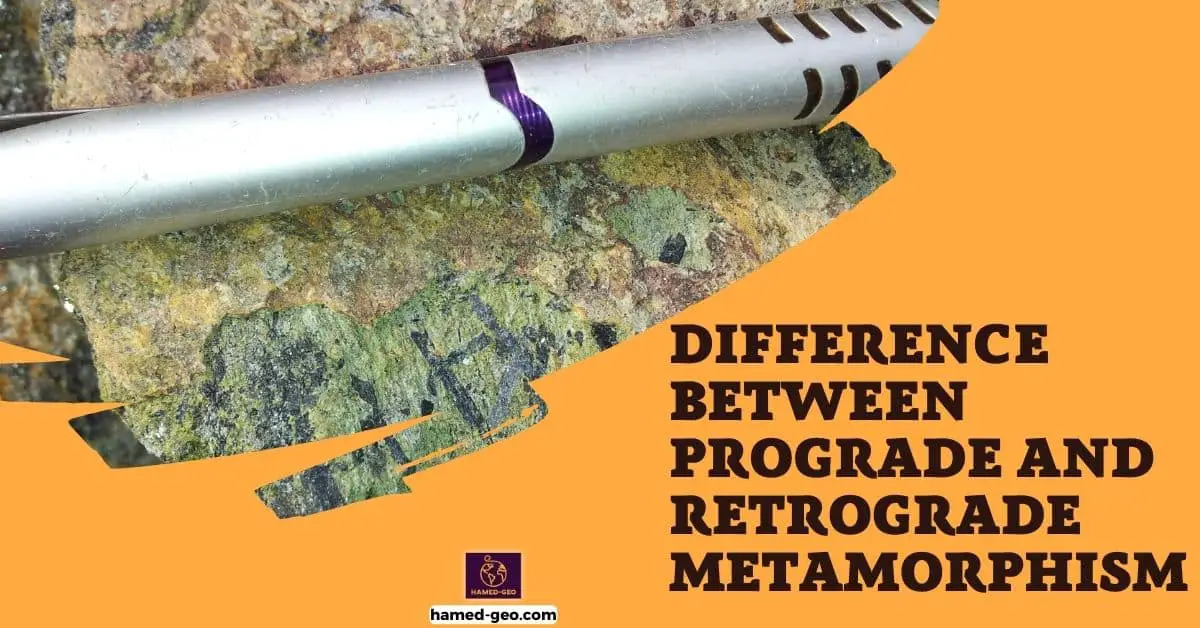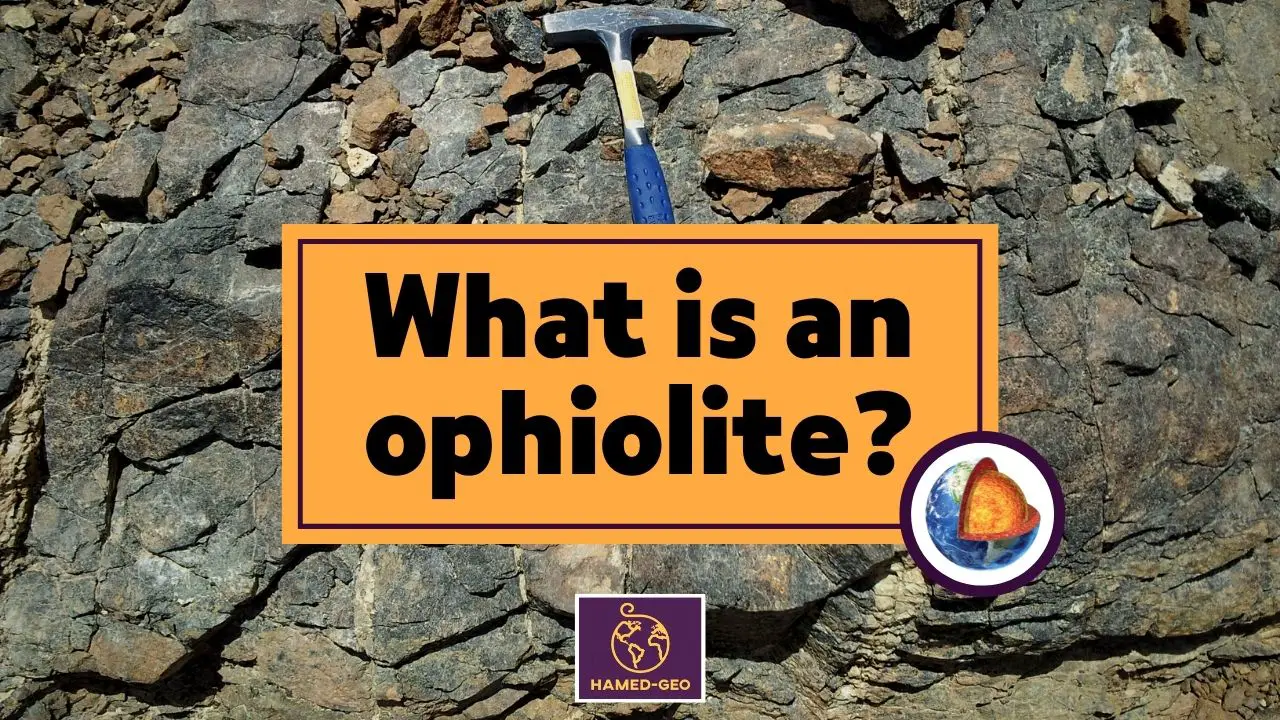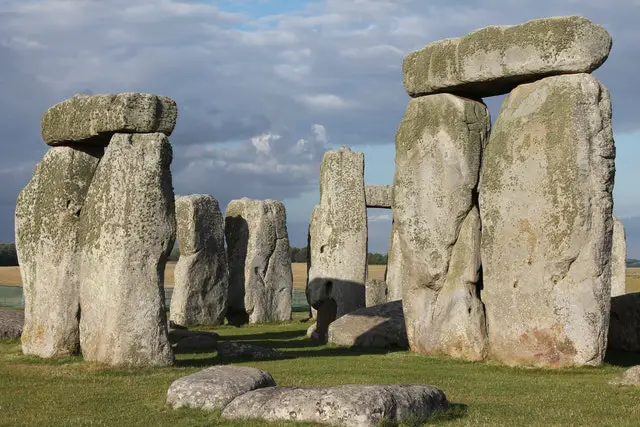Metamorphism is a geological process that involves the transformation of rocks due to changes in temperature, pressure, and chemical conditions. It can occur through two different mechanisms known as prograde metamorphism and retrograde metamorphism.
Here is a comparison table:
| Prograde Metamorphism | Retrograde Metamorphism | |
|---|---|---|
| Definition | Rocks undergo progressive changes in mineralogy and texture as temperature and pressure increase. | Rocks undergo changes in mineralogy and texture as temperature and pressure decrease. |
| Occurrence | Common in regions undergoing mountain building or orogenesis. | Commonly when uplifted rocks that have undergone prograde metamorphism are exposed to lower temperatures and pressure. |
| Temperature and Pressure | Temperature and pressure increase. | Temperature and pressure decrease. |
| Mineral Formation | Formation of new minerals and recrystallization of existing minerals. | Alteration or breakdown of minerals formed during prograde metamorphism, leading to the formation of new minerals. |
| Rock Examples | Gneiss from shale, schist from slate. | Amphibolite to greenschist. |
| Geological Significance | Indicates deeper burial and higher-grade metamorphism. | Indicates uplift and erosion, as well as the geological history of a region. |
Prograde metamorphism refers to the process in which rocks undergo progressive changes in mineralogy and texture as they are subjected to increasing temperature and pressure. This type of metamorphism commonly occurs in regions of the Earth’s crust that are undergoing mountain building or orogenesis. As the rocks are buried deeper within the Earth’s crust, they are exposed to higher temperatures and pressures, which causes the minerals to recrystallize and form new minerals. Examples of prograde metamorphism include the formation of gneiss from shale and the development of schist from slate. In prograde metamorphism, the rocks generally follow a specific metamorphic sequence, known as the grade sequence, which is characterized by the appearance and disappearance of certain minerals as the temperature and pressure increase.
Retrograde metamorphism, on the other hand, is the process in which rocks undergo changes in mineralogy and texture as they are subjected to decreasing temperature and pressure. This type of metamorphism commonly occurs when tectonic forces uplift rocks that have undergone prograde metamorphism to shallower depths. As the rocks are exhumed to lower temperature and pressure conditions, the minerals that formed during prograde metamorphism become unstable and may react with fluids or undergo recrystallization. Retrograde metamorphism can result in the formation of new minerals, such as chlorite and epidote, and the alteration of pre-existing minerals. An example of retrograde metamorphism is the alteration of amphibolite to greenschist as a result of tectonic uplift and erosion.

Differences Between Prograde and Retrograde Metamorphism
Temperature and pressure changes play a crucial role in differentiating between prograde and retrograde metamorphism. During prograde metamorphism, the temperature and pressure conditions increase, causing rocks to undergo mineralogical and textural changes. Rocks affected by prograde metamorphism are typically subjected to higher temperatures and pressures, leading to the formation of new minerals and the recrystallization of existing ones. Conversely, retrograde metamorphism occurs when temperature and pressure decrease, causing rocks to go through reverse changes in mineralogy and texture.
Temperature and Pressure Changes
To further understand the differences between prograde and retrograde metamorphism, it is important to examine the changes in temperature and pressure that occur during these processes. Temperature and pressure changes play a crucial role in the transformation of rocks and the formation of new minerals.
During prograde metamorphism, both temperature and pressure increase as the rocks are subjected to higher levels of heat and pressure. This increase in temperature is typically caused by the proximity to a heat source, such as a magma chamber or a deep-seated igneous intrusion. As the rocks are heated, the minerals within them become unstable and undergo chemical reactions, leading to the formation of new minerals. The increase in pressure, on the other hand, is usually a result of the overlying weight of the rocks or the tectonic forces acting on them. These changes in temperature and pressure drive the process of recrystallization, wherein the existing minerals rearrange themselves to form new minerals with different crystal structures and textures.
Retrograde metamorphism, on the other hand, is characterized by a decrease in both temperature and pressure. This typically occurs when rocks that have undergone prograde metamorphism are exposed to lower temperature and pressure conditions due to uplift and erosion. As the rocks are exhumed to shallower depths, they cool down and the minerals within them become stable again. The decrease in pressure is a result of the removal of the overlying weight of the rocks. This retrogressive metamorphic process can lead to the alteration or breakdown of minerals that formed during prograde metamorphism, resulting in the formation of new minerals that are more stable under the new conditions.
Rocks Affected by Prograde and Retrograde Metamorphism
Prograde and retrograde metamorphism are two distinct processes that occur within the Earth’s crust, resulting in the transformation of rocks under varying temperature and pressure conditions. While prograde metamorphism refers to the formation of new minerals and textures due to the increasing temperature and pressure, retrograde metamorphism involves the reversion of minerals back to their original state as the temperature and pressure decrease. Understanding the rocks that are predominantly affected by these two processes is crucial in comprehending the complex nature of metamorphic rocks.
In the case of prograde metamorphism, rocks that are predominantly affected include shale, which is a fine-grained sedimentary rock composed of clay minerals. During prograde metamorphism, shale undergoes a series of mineral transformations, resulting in the formation of new minerals such as mica, chlorite, and garnet. The increase in temperature and pressure causes the clay minerals within the shale to recrystallize into these new minerals, leading to the development of a foliated texture. Other rocks that are commonly affected by prograde metamorphism include limestone, which transforms into marble, and sandstone, which transforms into quartzite.
On the other hand, retrograde metamorphism predominantly affects rocks that have undergone prograde metamorphism in the past. These rocks have experienced high temperatures and pressures, leading to the formation of new minerals. However, as the temperature and pressure decrease during retrograde metamorphism, these minerals may become unstable and undergo chemical reactions, reverting back to their original state. For example, in the case of eclogite, a high-pressure metamorphic rock, the minerals such as garnet and omphacite that formed during prograde metamorphism can decompose into new minerals such as epidote and hornblende during retrograde metamorphism.
Understanding the rocks that are predominantly affected by prograde and retrograde metamorphism allows geologists to interpret the geological history of a region. By examining the mineral assemblages and textures present in metamorphic rocks, scientists can reconstruct the temperature and pressure conditions that these rocks have undergone. This knowledge provides valuable insights into the tectonic processes and geological events that have shaped the Earth’s crust over millions of years.
Pressure Conditions During Prograde and Retrograde Metamorphism
Prograde and retrograde metamorphism are two distinct processes in the field of geology. While prograde metamorphism involves the increase in temperature and pressure as rocks move deeper into the Earth’s crust, retrograde metamorphism occurs when rocks experience a decrease in temperature and pressure due to uplift and erosion. Understanding the pressure conditions during both prograde and retrograde metamorphism is crucial in comprehending the geological changes that occur within the Earth’s crust.
During prograde metamorphism, the pressure conditions generally increase as rocks are subjected to higher temperatures and greater depths within the Earth’s crust. This increase in pressure is a result of the overlying weight of the rocks and sediments above, known as lithostatic pressure. As rocks are buried deeper, the lithostatic pressure gradually increases, causing the minerals within the rocks to undergo chemical reactions and recrystallization. The increase in pressure during prograde metamorphism can lead to the formation of new minerals and textures, resulting in the metamorphic rocks acquiring distinct characteristics.
On the other hand, retrograde metamorphism occurs when rocks are uplifted to shallower depths, causing a decrease in pressure. This decrease in pressure during retrograde metamorphism can be attributed to the removal of overlying rocks through erosion. As the pressure decreases, the minerals in the rocks may undergo decompression reactions, leading to the formation of new minerals or the breakdown of existing ones. Retrograde metamorphism can result in the alteration or destruction of minerals formed during prograde metamorphism, leading to the development of different metamorphic rocks with unique mineral assemblages.
In conclusion, Prograde Metamorphism and Retrograde Metamorphism are two distinct processes that occur during the transformation of rocks under varying conditions. Prograde metamorphism involves the increase in temperature and pressure as rocks are subjected to deeper levels within the Earth’s crust. This process leads to the formation of new minerals and the recrystallization of existing ones. The minerals in prograde metamorphism tend to be more stable and have higher melting points, reflecting the increased temperature and pressure they have experienced.
On the other hand, retrograde metamorphism occurs when rocks that have undergone prograde metamorphism are subjected to decreasing temperature and pressure. This process can result from tectonic uplift or erosion, causing rocks to be exposed to surface conditions. During retrograde metamorphism, minerals may undergo changes in composition and texture as they readjust to the lower temperature and pressure. This can lead to the formation of new minerals and the breakdown of existing ones.
Understanding the differences between prograde and retrograde metamorphism is crucial in deciphering the geological history and evolution of rocks. By analyzing mineral assemblages and textures, geologists can determine the conditions under which rocks have formed and the subsequent changes they have undergone. This knowledge is invaluable for unraveling Earth’s past and predicting future geological processes.




[…] Here is an article explaining the Difference Between Prograde and Retrograde Metamorphism. […]